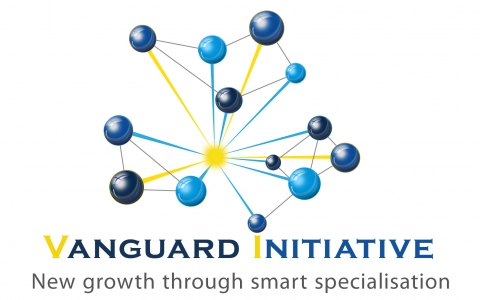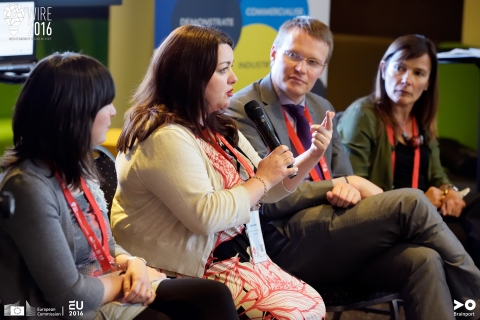. Portail de la Wallonie / Entreprendre en Wallonie / Fédération Wallonie-Bruxelles / Guide des institutions
WIRE Conference 2016 - Highlights of the 'Hosted by Vanguard Initiative' session (9 June 2016)
 From 8 to 10 June the Week of Innovative Regions took place in Eindhoven, The Netherlands. Vanguard Initiative was, during several parts of the program, presented as a promising example of interregional collaboration. The network was offered the opportunity to organize a ‘hosted by’ session during this conference. More than 40 participants attended the session. The session “Cross-regional collaboration for new industrial value chains : lessons from experience and needs for the future” was opened by Noord-Brabant Vice Governor Bert Pauli, as South Netherlands Vanguard Initiative chair, who emphasized the business and investment orientation of our initiative, while welcoming the EU S3 thematic platform initiatives, inspired by the Vanguard Initiative experience.
From 8 to 10 June the Week of Innovative Regions took place in Eindhoven, The Netherlands. Vanguard Initiative was, during several parts of the program, presented as a promising example of interregional collaboration. The network was offered the opportunity to organize a ‘hosted by’ session during this conference. More than 40 participants attended the session. The session “Cross-regional collaboration for new industrial value chains : lessons from experience and needs for the future” was opened by Noord-Brabant Vice Governor Bert Pauli, as South Netherlands Vanguard Initiative chair, who emphasized the business and investment orientation of our initiative, while welcoming the EU S3 thematic platform initiatives, inspired by the Vanguard Initiative experience.
Moderated by Wim De Kinderen, Brainport Eindhoven EU office (South Netherlands), several speakers tapped into their experience in the field of interregional industrial collaboration. Carsten Schierenbeck, EC DG GROW, shed light on the need for a new approach to deal with the increasing complexity of industrial value chains, and presented  the new EC initiatives for fostering cross-regional and cross-cluster collaboration. Lesley Ward, Scottish Government EU Office, illustrated the Vanguard Initiative approach and methodology, as well as the progress achieved so far in ensuring stakeholder and industry engagement in collaborative activities. Prof. Anna Giorgi, Milan University, shared the EUSALP macro-region experience so far in developing cross-regional collaboration on a territorial basis, and pointed to the Vanguard Initiative as a valuable source of learning. Finally, Cristina Ugarte, Innobasque, highlighted the potential of MANUNET – an ERA-NET Cofunded initiative – to support collaborative R&D projects based on a mix of regional and national fundings. This could also be mobilised in the context of the Vanguard Initiative.
the new EC initiatives for fostering cross-regional and cross-cluster collaboration. Lesley Ward, Scottish Government EU Office, illustrated the Vanguard Initiative approach and methodology, as well as the progress achieved so far in ensuring stakeholder and industry engagement in collaborative activities. Prof. Anna Giorgi, Milan University, shared the EUSALP macro-region experience so far in developing cross-regional collaboration on a territorial basis, and pointed to the Vanguard Initiative as a valuable source of learning. Finally, Cristina Ugarte, Innobasque, highlighted the potential of MANUNET – an ERA-NET Cofunded initiative – to support collaborative R&D projects based on a mix of regional and national fundings. This could also be mobilised in the context of the Vanguard Initiative.
The sharing of experiences highlighted key elements for successful collaborations, the main bottlenecks, and identified some ideas about the way forward. In summary:
Key elements for successful cross-regional collaboration
- Governance: the political involvement is a driver for other stakeholders’ engagement, this buy-in permits the public sector to act as a facilitator for industry engagement. It is important that this is timed correctly to ensure that industry understands what is in it for them. The role of each evolves through the different stages of the methodology, with public authorities gradually shifting to the background and industry taking more of a lead as cases develop towards full commercialisation;
- Data and mapping of resources, capability and capacity is the starting point for identifying opportunities for collaboration;
- Building trust and commitment is key in the process;
- Good planning, a clear outcome and defined activities are essential;
- Learning by doing allows identification of bottlenecks and sharing of experiences;
- A mix of policy ingredients (framework conditions, support tools, financing,…) is required to create a cluster-type policy approach.
Main bottlenecks to collaboration
- Lack of involvement of institutions and at a political level can be an obstacle in leveraging funding from the regions;
- Moving from being competitors to collaborators;
- Reconfiguration of value chains brings more complexity and requires mixing competencies as they are cross-cutting across regions, sectors, firms and people;
- Investor readiness, which means tackling issues such as IPR management, funding mix, market foresight and putting the right team together with the right expertise;
- Complexity of procedures, non-harmonised rules, inefficient ways of working;
- The Vanguard Initiative approach – ‘building the road whilst driving’ (quoting Richard Tuffs at the closing session) - involves costs and risks for the leading regions and stakeholders.
The ways to go
- Using clusters as bridges between actors within regions and outside and as channel for business support to SMEs; smart specialization strategies can also be used as basis for triggering cross-regional collaboration;
- Develop support tools dedicated to groups of enterprises (rather than to individual ones), to cross-sector approaches and EU partnerships;
- Developing support for mapping capability across regions to identify opportunities and as a mean for building collaboration around a shared strategic interest. This also means building capacity, to build trust and to gather interest, this requires dedicated incentives;
- Identifying and removing bottlenecks to combining funds - simplification;
- Exploring the opportunities for developing vouchers to facilitate SMEs’ access to Research, Development and innovation (RDI) services, as well as funding schemes like ERA-NETs to support collaboration;
- The Commission has already taken steps to develop new support tools, like the INNOSUP calls supporting cluster collaboration around emerging value chains and the European Strategic Cluster Partnerships for smart specialisation investment which will be supported through a dedicated COSME call in 2017, with a budget of € 2,8 Millions.
- Showing results of current experiences will be key for developing those approaches further!
The session was closed by a lively exchange between the room and the speakers.
The main conclusion of the session was that trusted relationships are necessary to deliver Interregional collaboration that is focused on real economic impact. These relationships need to be founded on evidence and capacity and require long term engagement. Interregional collaboration focused on real economic impact calls for a mix of support measures - financial but also others - implemented by a mix of public and private stakeholders, whose tasks, roles and responsibilities shift over time. A coordinated and cluster based approach is key.



